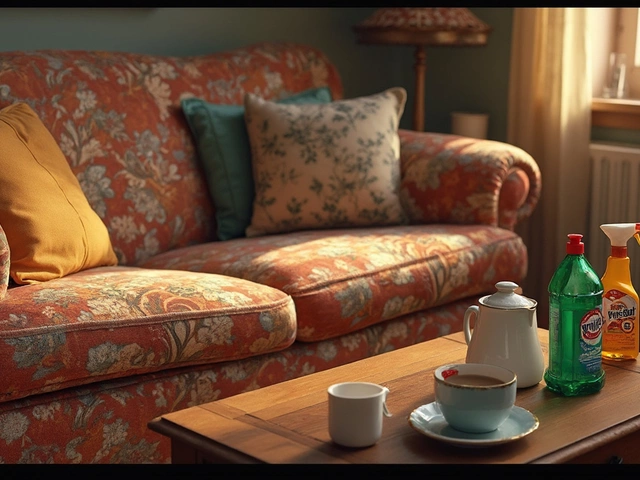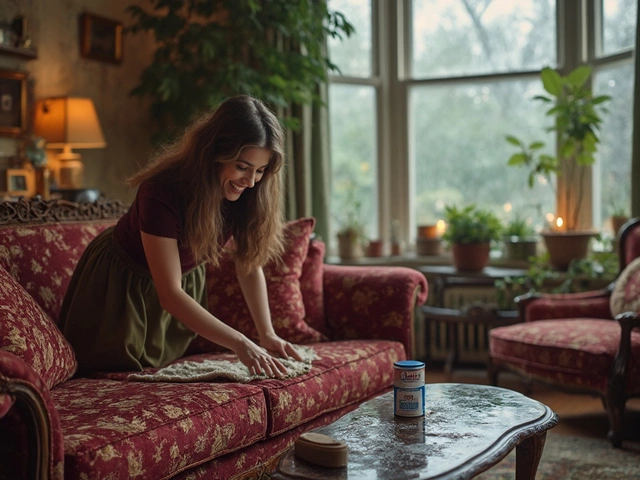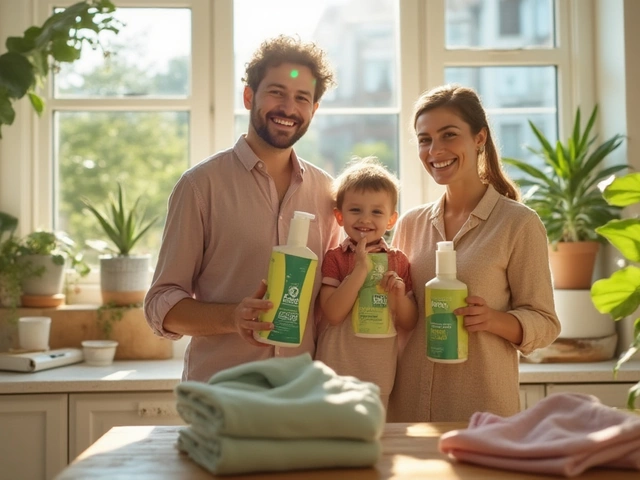Tackling toilet scale is often a dreaded task, especially when moving out and wanting to leave your space pristine for the next resident. These mineral deposits, which appear as unsightly stains, can be quite tough to remove if left unattended for long periods. But don't fret!
There are various ways to approach this cleaning challenge. Whether you're inclined to use natural solutions found in your pantry or lean towards commercial cleaning options, quick and effective methods are available. Additionally, preventing scale from building up in the first place can save you from future headaches, ensuring your bathroom remains spotless with minimal effort.
- Understanding Toilet Scale
- DIY Cleaning Solutions
- Effective Commercial Products
- Preventing Future Build-up
- Unexpected Household Helpers
- Final Cleaning Touches
Understanding Toilet Scale
Toilet scale is a common issue facing anyone responsible for cleaning a bathroom. It is an accumulation of calcium carbonate and other minerals present in hard water, which gradually solidify and settle in areas where water is frequently standing or evaporating—most prominently inside toilet bowls. The impact is not just aesthetic; if left unchecked, this build-up can affect the functionality of your fixtures, leading to costly repairs. The persistence of these stains lies in their chemical makeup. Over time, even the smoothest porcelain becomes pitted by the abrasive nature of the mineral deposits, causing them to cling on more effectively as they bond with the surface.
Understanding what causes toilet scale has everything to do with recognizing the components in your tap water supply. Hard water, categorized by its high mineral content, is the main contributor. Calcium and magnesium ions dissolve in water from the nearby rock formations or sediment they filter through, presenting a particular challenge in various regions globally. It's worthy to note that approximately 85 percent of the United States alone deals with hard water issues in some capacity, as reported by the Water Quality Association.
"The simplest solutions often prove the most effective, especially when tailored to your specific water composition," says Jane M. Haughey from the Cleaning Lab at the Good Housekeeping Institute.In its initial stages, toilet scale might appear as a faint white or greyish ring inside the bowl. As the layers build, these deposits can darken, creating unsightly brown stains that become progressively resistant to standard cleaning methods. Visually displeasing and seemingly relentless, eliminating them requires a systematic approach. Scrubbing alone proves futile without proper techniques and persistent efforts over the long haul.
For those seeking to proactively combat this problem, periodically checking local water reports can offer significant insights into your area's water hardness level. Such information arms you with the knowledge needed to implement preventive measures. Incorporating water softeners at home or adjusting your cleaning routine to more frequently tackle water-prone surfaces can significantly minimize scale buildup. Prevention, though sometimes more tedious upfront, plays a critical role in reducing the longer-term labor associated with cleaning and maintains your bathroom fixtures in top condition.
DIY Cleaning Solutions
When it comes to tackling the issue of toilet scale removal, a variety of DIY techniques can save not only money but also provide a sense of accomplishment. Many household items are not just for cooking or cleaning the dishes—they can effectively work against those stubborn mineral deposits that plague our toilets. A common and natural favorite for this task is vinegar. Its acetic acid content makes it an excellent tool for breaking down calcium and lime deposits. To effectively utilize vinegar for this purpose, start by gathering a generous amount of white vinegar and pouring it directly into the toilet bowl. Let it sit overnight; this allows the acidity in the vinegar to work on the scale, breaking down its structure quietly while you sleep.
In the morning, give it a good scrub with a toilet brush, focusing on areas where scale is clearly visible. The gentle yet effective nature of this approach is perfect for those who favor eco-friendly methods. If extra grit is required, baking soda can be combined with vinegar. Sprinkling baking soda into the bowl and adding vinegar creates a fizzy chemical reaction that can tackle more stubborn scale, just like a school science project produces significant fizz and pop, similarly, this combination can surprise you with its efficacy.
Another natural ally in the fight against scale is lemon juice, loaded with citric acid—it carries a powerful punch to fight mineral buildup. Lemons are not just for lemonade; their acidic nature makes them perfect fighters against calcium deposits. Simply squeeze fresh lemon juice into the toilet bowl or opt for bottled concentrates if fresh lemons aren't readily available. Leave it to soak before scrubbing, and enjoy not just a cleaner toilet but a refreshing citrus scent afterward. There's something simple yet satisfying about using what nature provides in such daily tasks. As Henry David Thoreau wisely noted, "Our life is frittered away by detail... simplify, simplify." This simplicity can indeed be profound in our cleaning chores as well.
Apart from these, salt and hydrogen peroxide can be quite beneficial. Salt acts as a mild abrasive to physically scrub down scale and other stains while hydrogen peroxide's chemical properties penetrate and dissolve grime. Simply apply some salt onto a brush and scrub affected areas, or apply hydrogen peroxide generously and let it work for a few minutes before rinsing down. These methods are sure to cover various preferences and situations, transforming a tedious scrubbing session into an effective home science trial, often with wonderful results. If you're consistent with these practices, your commode should maintain its sparkling clean visage, sidestepping any unwelcome scrutiny during end-of-tenancy cleaning.
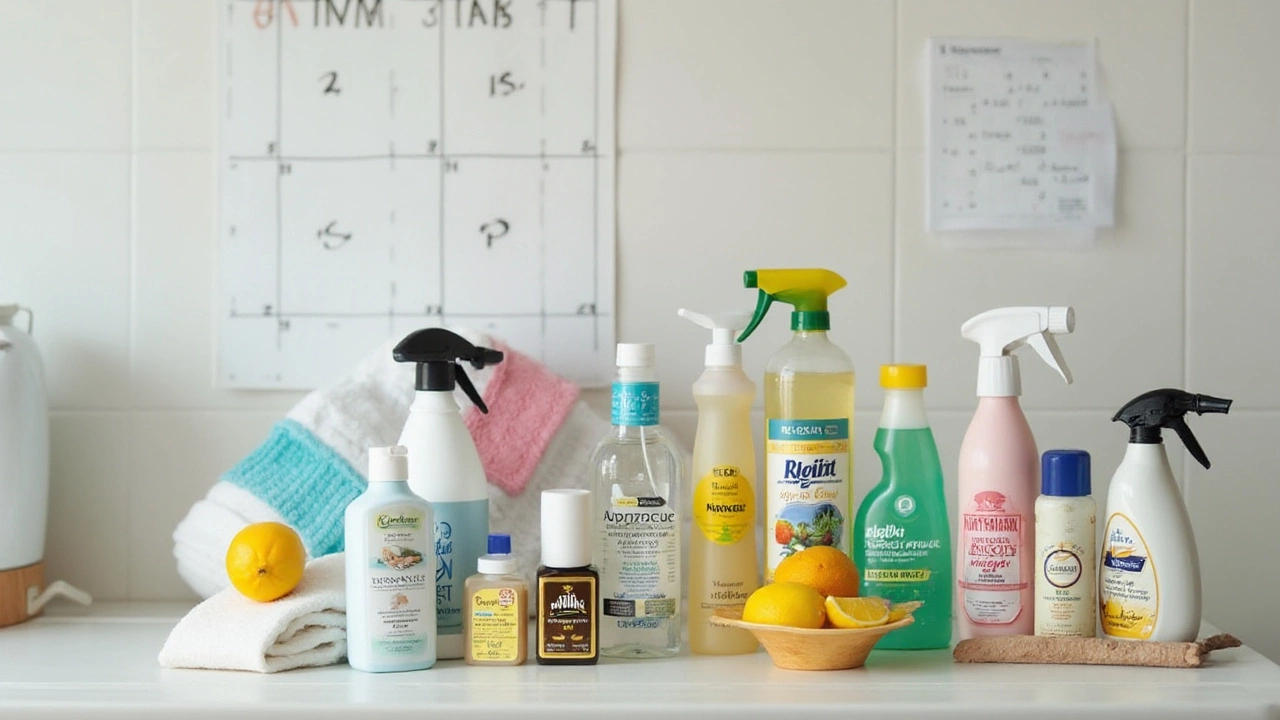
Effective Commercial Products
When it comes to battling toilet scale, commercial products often come out on top due to their strong formulations specifically designed to tackle stubborn stains. Among the widely trusted brands, Lime-A-Way and CLR (Calcium, Lime, and Rust Remover) have garnered popularity for their ability to break down scale deposits with minimal effort. These products utilize chemical reactions that soften and dissolve the mineral build-up, making scrubbing an easier task.
Many users swear by the effectiveness of these cleaners, often finding that regular application can keep unpleasant stains from hardening over time. What makes products like CLR particularly appealing is their versatility; they can be used not just in toilets but on sinks and tubs too, which often suffer from the same issues. The multipurpose aspect ensures that a single bottle can go a long way in maintaining an entire room's cleanliness.
Using commercial products is often straightforward, involving a simple application and rinse process. For example, when using Lime-A-Way, it's recommended to apply the solution generously on the stained areas, let it sit for about 10 minutes allowing it to break down the scale, and then proceed to scrub with a toilet brush. The results are usually immediate, with even the most resistant of stains showing significant improvement. Its ability to work so efficiently restores the pristine look of your bathroom fixtures confidently.
Important to note is the safety precautions that one must take when using these products. The powerful chemicals contained can cause irritation if they come into contact with skin or eyes. It's advised to wear gloves and ensure the area is well-ventilated while cleaning.
According to Dr. Jane Quinn, a renowned cleaning expert, "Proper handling and application of commercial cleaners often guarantee the best results with minimal manual labor."This reaffirms the importance of adhering to safety instructions provided by manufacturers.
For those who care about eco-friendly options, brands like Ecover and Method offer alternative commercial cleaners that promise a lower environmental impact without sacrificing effectiveness. They make use of plant-based ingredients as opposed to harsh chemicals, which is appealing for environmentally-conscious individuals. This aspect can also be a deciding factor in selecting a commercial cleaner, especially in households where conventional chemical smells might be bothersome to sensitive noses.
The convenience of these ready-to-use formulas, combined with their potent results, makes them a valuable ally during end-of-tenancy cleaning, when time and effectiveness are critical. To conclude, by incorporating reliable commercial products into your cleaning routine, tackling even the most persistent toilet scale becomes much less of a chore, allowing your bathroom to gleam with newfound brightness.
Preventing Future Build-Up
Wouldn't it be nice to avoid the headache of scrubbing away at stubborn toilet scale buildup altogether? While cleaning is always going to be a part of life, a few proactive measures can vastly reduce the frequency and intensity of your cleaning routine. By understanding the root causes, like hard water, and adopting some straightforward habits, you can keep those unsightly mineral deposits at bay. One crucial step is to regularly flush your toilet even if it has not been used frequently. This helps prevent mineral deposits from drying and calcifying, a key factor that contributes to scale creation.
Adding a water softener system to your home might be a more costly but highly effective long-term solution. Hard water is rife with minerals like calcium and magnesium, the usual culprits behind toilet scale. By treating your water, you can make scale less likely to form on not just toilet bowls, but taps, pipes, and other fixtures too. It's noteworthy from the Consumer Council of Water that the average household in areas with hard water can prolong the lifespan of their plumbing systems by using a softener.
"Preventative measures can save up to 25% of your plumbing replacement costs," according to Dr. Harriet M. From the American Cleaning Institute.
Another way to fend off toilet scale is to regularly use vinegar or a descaling solution. A splash of white vinegar or a corresponding commercial product down the toilet bowl once or twice a week can work wonders. These acids are powerful yet gentle; they dissolve mineral build-up without eroding the ceramic finish of your toilet bowl. Some swear by incorporating a little borax along with vinegar for an added boost, and surprisingly, these can become your frontline defense in minimizing scale.
Besides chemical methods, think about mechanical ones too. Cleaning your toilet brush regularly and using it frequently stops scale from having any invitation to settle. Create a habit of doing a quick brush-around every today or tomorrow; it pays off in the long run. Moreover, check the environment in which your toilet resides. Consistent ventilation keeps the bathroom free from excess humidity, a lesser-known factor that subtly contributes to the formation of scale.
For a busy household, investing in automatic toilet bowl cleaners can be a real lifesaver. These gadgets can hang inside the toilet tank dispensing cleaner into the water with each flush. While they may not completely eradicate scale, they'll certainly help reduce it considerably by maintaining a level of cleanliness at all times. Ensure the cleaner you use is appropriate for your water type and household plumbing for best results.
Finally, be aware of any slight discolorations or initial rough spots you might see when you glance into the bowl. Tackling these the moment you notice them can stop scale in its tracks. As it grows over time, it often becomes more difficult to remove, meaning the early bird really does catch the worm here. Proper vigilance combined with appropriate action is your best friend in keeping that nagging toilet scale away.
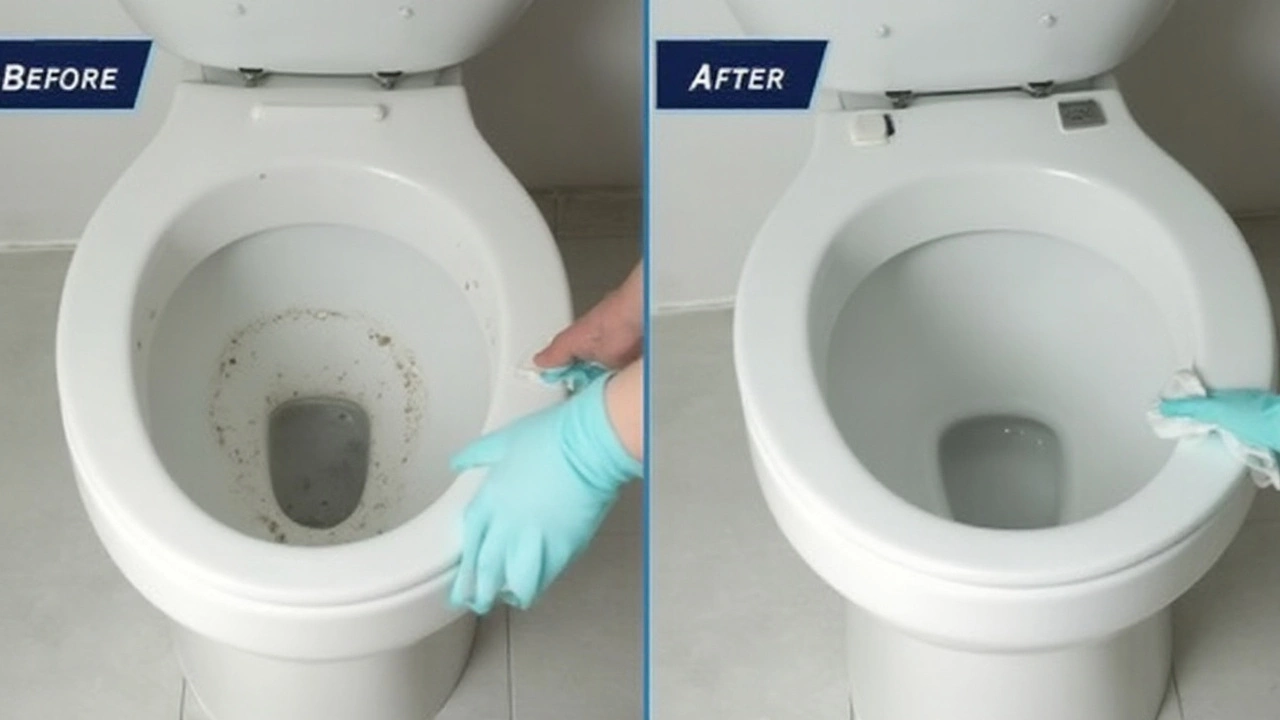
Unexpected Household Helpers
When it comes to the battle against stubborn toilet scale, some unexpected household helpers might just turn out to be your secret cleaning allies. Imagine reaching into your kitchen cabinet and pulling out everyday items that double as powerful cleaning agents. While the usual suspects like vinegar and baking soda are well-talked about, several lesser-known elements can play a significant role in tackling the gritty matter in your toilet bowl.
First, let's delve into the power of cola. Yes, the fizzy drink you enjoy on a hot day also works wonders on toilet scale removal. The acidity of cola, primarily due to its phosphoric acid content, helps break down mineral deposits. Simply pour a can into the bowl, let it sit overnight, and in the morning, give it a good scrub. Anecdotal evidence from various households suggests surprisingly effective results. Another curious item that might raise an eyebrow is toothpaste. While it’s typically seen on toothbrushes, a small dab on a scrubber can scrub away lighter deposits. The mild abrasives in toothpaste contribute to lifting off scale deposits without scratching the porcelain.
The next household hero may surprise you—denture tablets. Designed to clean dentures, these tablets contain components that are adept at dissolving organic residue and mineral buildup. To use them effectively, drop a tablet or two into the water, wait for it to fizz and dissolve, then work your toilet brush magic. Additionally, not many are aware of the potential of hydrogen peroxide, commonly found in first-aid kits. Its oxidizing properties can soften hard water deposits, making them easier to dislodge. Simply pour a half-cup into the toilet bowl and let it work its magic for around 20 minutes before scrubbing.
If you're looking for a quirky yet effective solution, consider using tartar sauce. The cream of tartar within the sauce assists in loosening mineral buildups. Mixed with a bit of baking soda, it doubles as a cleaning agent. Let this mixture sit for an hour before rinsing it away. Adding a twist to your cleaning strategy with such readily available items not only saves money but is also an eco-friendly move, repurposing what could be waste into useful tools.
An insightful saying from the late Mary Lou Retton comes to mind:
Final Cleaning Touches
After you've tackled the previous steps to combat toilet scale, it's time to add those final cleaning touches that will leave your bathroom sparkling. Every detail counts when you're preparing for a tenant move-out, and these last steps ensure no stone—or in this case, fixture—is left unpolished. Start by checking the water tank. Often overlooked, a quick clean out of the tank can prevent unseen sediment from reinfecting your recently cleaned toilet bowl. Simply without too much fuss, drain, and rinse the tank. Fill it with a mixture of vinegar and water to dissolve mineral deposits hiding within.
Next, pay attention to the fittings and surrounding areas of the toilet. Tighten any loose fixtures and polish metal parts with a dedicated cleaner that leaves a gleaming shine. Dust and cobwebs can accumulate in the most neglected areas, so wipe down corners of walls and the toilet's lower floor area. Adding some brightening touches could be a lifesaver. "Cleanliness is next to godliness," as Mahatma Gandhi eloquently captured, and this pursuit of purity extends to every nook within your bathroom.
Re-evaluate all silicon seals and edges. Mold and scale love these spots, so take special care and scrub them using a brush dipped in hydrogen peroxide to kill bacteria and whiten any discoloration. Place a deodorizing gel puck under the rim or a subtle fragrance spray on the top tank to leave a fresh scent wafting post-cleaning. Lastly, don't forget the final look. Perform a visual inspection to ensure no cleaning residue lingers around edges and surfaces, for a truly spot-free result. See it as your signature after hours of hard work that shows a commitment to excellence.
For those wondering whether doing the extra mile is worth it, British studies show that pristine bathrooms increase renting attractiveness by 20%, highlighting just how crucial final cleaning really is. A clean bathroom is more than just an obligation; it's a statement of care and consideration for the next individual calling it a home. Embrace this ethos, and the rewards will undoubtedly follow.
